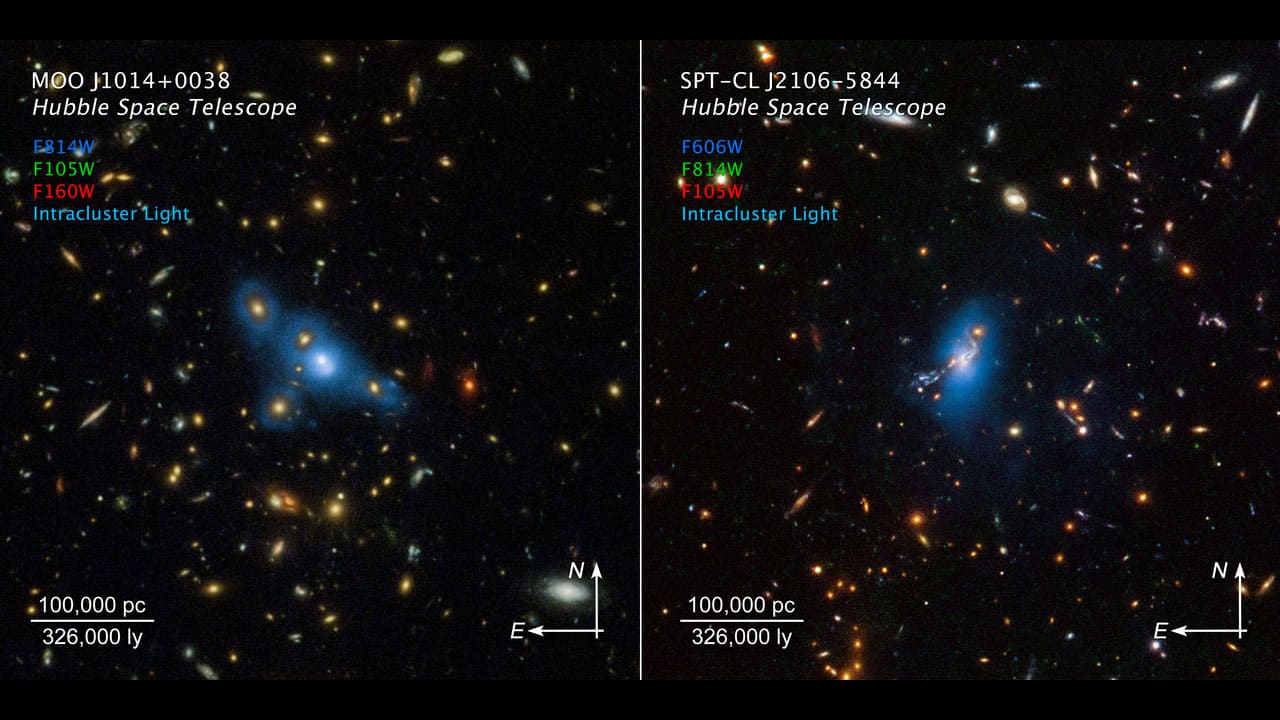
Diffuse light from stars gravitationally connected to the halo of galaxy clusters rather than to specific member galaxies is known as intracluster light (ICL). The ICL fraction, determined by the ratio of the ICL to the total light, is expected to rapidly decline with increasing redshift until it reaches a level of a few percent, according to leading theories. Because just two clusters have been studied in this redshift domain, observational investigations have yet to determine the proportion beyond redshift unity.
The nagging question for astronomers has been: how did the stars get so scattered throughout the cluster in the first place?
A recent infrared survey from NASA‘s Hubble Space Telescope, which looked for this so-called “intracluster light,” sheds new light on the mystery. According to the latest Hubble findings, these stars are not the result of more recent dynamical activity within a galaxy cluster, which would have stripped them out of typical galaxies but have been wandering about for billions of years.
Ten galaxy clusters nearly 10 billion light-years distant were included in the survey. The faint intracluster light is 10,000 times fainter than the night sky as seen from the ground. Therefore these measurements must be taken from space.
It was found that the fraction of the intracluster light relative to the total light in the cluster remains constant, looking over billions of years back into time. It suggests that these stars were already homeless in the early stages of the cluster’s formation.
James Jee of Yonsei University in Seoul, South Korea, said, “Stars can be scattered outside of their galactic birthplace when a galaxy moves through gaseous material in the space between galaxies, as it orbits the center of the cluster. In the process, drag pushes gas and dust out of the galaxy. However, based on the new Hubble survey, we rule out this mechanism as the primary cause for the intracluster star production. That’s because the intracluster light fraction would increase over time if stripping is the main player. But that is not the case in the new Hubble data, which show a constant fraction over billions of years.”
“We don’t exactly know what made them homeless. Current theories cannot explain our results, but they were produced in large quantities in the early universe. In their early formative years, galaxies might have been small, and they bled stars easily because of a weaker gravitational grasp.”
Hyungjin Joo of Yonsei University, the paper’s first author, said, “If we figure out the origin of intracluster stars, it will help us understand the assembly history of an entire galaxy cluster, and they can serve as visible tracers of dark matter enveloping the cluster.”
The wandering stars would be unable to trace the distribution of the cluster’s dark matter if they were created by a very recent pinball game between galaxies because they did not have enough time to distribute over the whole gravitational field of the cluster. The stars will, however, have entirely spread throughout the cluster if they were born in the early years of the cluster. This would enable astronomers to map out the distribution of dark matter throughout the cluster using the errant stars.
By observing how the entire cluster warps light from background objects due to a phenomenon known as gravitational lensing, this method is novel and adds to the conventional way of dark matter mapping.
Journal Reference:
- Joo, H., Jee, M.J. Intracluster light is already abundant at redshift beyond unity. Nature 613, 37–41 (2023). DOI: 10.1038/s41586-022-05396-4
https://news.google.com/__i/rss/rd/articles/CBMiUmh0dHBzOi8vd3d3LnRlY2hleHBsb3Jpc3QuY29tL2dob3N0LWxpZ2h0LWFtb25nLWdhbGF4aWVzLXN0cmV0Y2hlcy1mYXItdGltZS81NTgwOC_SAVhodHRwczovL3d3dy50ZWNoZXhwbG9yaXN0LmNvbS9naG9zdC1saWdodC1hbW9uZy1nYWxheGllcy1zdHJldGNoZXMtZmFyLXRpbWUvNTU4MDgvP2FtcD0x?oc=5
2023-01-05 05:54:36Z
CBMiUmh0dHBzOi8vd3d3LnRlY2hleHBsb3Jpc3QuY29tL2dob3N0LWxpZ2h0LWFtb25nLWdhbGF4aWVzLXN0cmV0Y2hlcy1mYXItdGltZS81NTgwOC_SAVhodHRwczovL3d3dy50ZWNoZXhwbG9yaXN0LmNvbS9naG9zdC1saWdodC1hbW9uZy1nYWxheGllcy1zdHJldGNoZXMtZmFyLXRpbWUvNTU4MDgvP2FtcD0x
Tidak ada komentar:
Posting Komentar